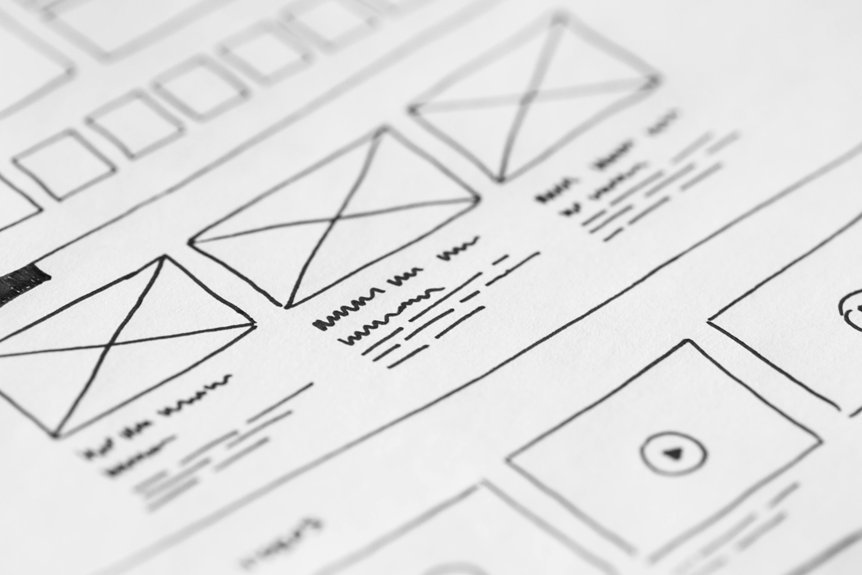Turning an idea into a tangible product starts with a clear plan and precise execution. You’ll need to move from digital concepts to physical prototypes, testing and refining along the way. This process can be complex, involving careful choices and iterative adjustments. Understanding each step is essential to bringing your concept to life efficiently. So, what are the key stages that make prototype development successful, and how can they help you achieve your goals?
Defining Your Objectives and Requirements
How do you guarantee your prototype meets its intended purpose? Start with thorough market research to understand user needs and industry standards. Conduct stakeholder analysis to identify key expectations and gather valuable insights. Clearly define your objectives by aligning your goals with market demands and stakeholder priorities. Utilizing a patent search can also help you identify existing solutions and ensure your idea’s originality. Establish specific requirements that address functionality, usability, and constraints. This foundation ensures your prototype is targeted and effective. By integrating market research and stakeholder input early, you minimize risks and set a clear direction.
Defining objectives and requirements this way ensures your prototype truly serves its purpose and resonates with your audience.
Sketching and Conceptual Design
Once you have a clear understanding of your objectives and requirements, the next step is to begin sketching and developing conceptual designs. Start with rough conceptual sketches to explore different ideas quickly. These sketches capture your initial thoughts and help visualize potential solutions.
Conduct ideation sessions to gather insights, refine concepts, and challenge assumptions. Focus on broad concepts first, then narrow down your options. Remember, the goal is to generate a variety of ideas without overthinking details.
This phase sets the foundation for your prototype, so be creative, open-minded, and willing to iterate as you develop your design.
Selecting Materials and Technologies
Choosing the right materials and technologies is a crucial step in turning your conceptual designs into a functional prototype. Advanced manufacturing techniques allow you to produce complex parts efficiently and with high precision.
Prioritize sustainable materials to reduce environmental impact and ensure your prototype aligns with eco-conscious goals. Consider factors like durability, weight, and compatibility with your design when selecting materials.
Technologies such as 3D printing or CNC machining can streamline production and improve accuracy. By carefully choosing these elements, you set a solid foundation for creating a reliable, innovative prototype that meets both technical and sustainability standards.
Creating a Digital Model and Simulations
Have you considered how creating a detailed digital model can transform your prototype development process? By utilizing virtual reality, you can immerse yourself in a realistic environment to test your design’s functionality and ergonomics.
Simulations allow you to identify potential flaws early, saving time and resources. A well-designed user interface in your digital model makes it easier to navigate and adjust features quickly.
This approach helps you visualize complex interactions, refine your concept, and gather valuable feedback before moving to physical prototyping. Digital models and simulations streamline development, ensuring your final product aligns perfectly with your vision and user needs.
Building the Physical Prototype
Building the physical prototype brings your digital concepts into tangible form, allowing you to evaluate design features firsthand. Focus on ergonomic considerations to guarantee comfort and usability, making adjustments based on how users interact with the prototype.
At the same time, consider the environmental impact of materials and manufacturing processes. Choose sustainable options where possible to reduce waste and energy consumption.
This stage helps you identify practical issues early, enabling refinements that improve both functionality and sustainability. Ultimately, creating a well-considered physical prototype bridges the gap between concept and real-world application, setting the stage for successful testing and development.
Testing and Gathering Feedback
Testing and gathering feedback are essential steps to guarantee your prototype functions as intended and meets user needs. By observing how users interact with your prototype, you gain valuable insights into the user experience, identifying areas for improvement.
Market testing allows you to evaluate how your product performs in real-world conditions, revealing potential issues and confirming its appeal. Encourage honest feedback from diverse users to uncover hidden flaws and understand different perspectives.
This process helps you make informed decisions, ensuring your design aligns with user expectations and market demands before moving forward with refinements.
Refining and Iterating the Design
Once you’ve gathered sufficient feedback and identified areas for improvement, the next step is to refine and iterate your design.
Focus on enhancing the design aesthetics to create a more cohesive and appealing look. Tweak the user interface to improve usability, ensuring controls are intuitive and responsive.
Pay attention to visual consistency, color schemes, and layout to make the product more engaging. Test these changes quickly with users, gather new insights, and make further adjustments.
This iterative process helps you develop a polished, user-friendly prototype that aligns with your vision and meets user expectations effectively.
Preparing for Production and Scaling
As you prepare your prototype for production and scaling, it’s vital to make certain that your design elements, materials, and manufacturing processes are optimized for large-scale deployment. Conduct a thorough market analysis to understand demand, competition, and potential challenges.
Simultaneously, perform accurate cost estimation to guarantee profitability and identify areas to reduce expenses. These steps help you refine your approach, prioritize efficient materials, and select manufacturing methods suitable for mass production.
Conclusion
By following these steps, you turn your innovative ideas into real, functional products. Clear objectives, careful design, and smart material choices set the foundation. Digital modeling and physical testing help refine your prototype, ensuring it meets all standards. Keep iterating based on feedback until you’re ready to scale. This systematic approach bridges creativity and practicality, helping you bring your concept to life efficiently and sustainably. To learn more on how to bring your idea or invention to market, visit us online at Inventors IPO.

